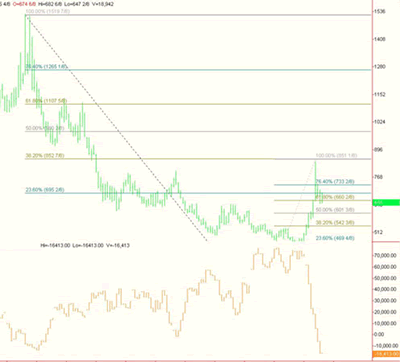Russian drought news has been the dominant factor in the grain markets this summer. Wheat prices began to rally in early June as commercial traders fully supported the lows around $4.50, while accumulating a net long position of over 80,000 contracts. At this time, the Russian drought news began to hit the wires. The month of July was fueled by the daily weather reports across Europe as this turned out to be the worst drought in 50 years. Wheat prices sky rocketed to $8.41 by August 6 and have since been in a trading range between $6.45 and $7.34 while waiting for further assessment of the weather’s impact on this year’s crop.
Facts are now replacing hyperbole. It has been reported that Russian wheat will be off by 31% along with a carryover effect to a winter wheat crop that will also be off about the same amount late this year. Global wheat production is expected to be around 660 million metric tons for 2010. Russia was expected to produce around 60 million bushels and will end up closer to 40 million metric tons. Considering ending stock surplus is around 175 million metric tons as of the end of 2009, Russia’s 20-million-ton shortfall should be easily covered.
Now that the actual numbers are starting to come out, there are three important points to be made in this example:
1) The futures markets are completely democratic. Everyone has access to trade them and the prices represent global supply and demand. This means that farmers all over the world compete to create the best available bids and offers. This also means that local farmers have access to the best global bids and offers, and therefore, are not tied to the local grain elevator operator’s basis offers $.60 - $1.50 below the futures price. This is exactly the type of market inefficiency that the exchanges were created to eliminate.
2) There have been nine years in the last 25 when global wheat production did not exceed global wheat consumption. The surplus that was created by 16 years worth of excess production makes up the global ending stocks and provides the cushion necessary to make up for anomalies like Russia’s drought. In spite of sporadic annual wheat deficits, at no point over the last 25 years have global wheat ending stocks dropped below 50 days worth of supply.
3) Following the commercial traders provided actual trading opportunities, while the media fueled hysteria with headlines like, “Worst Russian Drought in 50 Years,” “Russia Imposes Ban on Exports,” “Global Warming Killing Crops,” etc. Commercial traders went from long 80,000 contracts when they collectively felt that wheat was undervalued below $4.75 to currently short 10,000 contracts. The 90,000 contracts sold represent commercial wheat traders’ analysis of their market and the consensus of all of the fundamental factors affecting it. Their actions can also be seen through technical analysis that shows the wheat market stopping dead at the 38% Fibonacci retracement level from the January 2008 highs over $15 to the lows at $4.40.
The next actionable clue to future movement in the wheat market will be seen in technical analysis that points to a retracement to $6.05. This represents a 50% retracement from the $8.50 highs to the $4.40 low. We will combine our technical expectations with commercial traders’ actions through this consolidation between $6.45 and $7.34 to form a cohesive trading plan involving both fundamental and technical analysis that cuts through the media’s noise and allows us to place trades based on proactive action, rather than reactive reaction.
By Andy Waldock
Andy Waldock is a trader, analyst, broker, and asset manager. Therefore, Andy may have positions for himself, his family, or clients in any market discussed. Andy can be found at CommodityAndDerivativeAdv.com






















